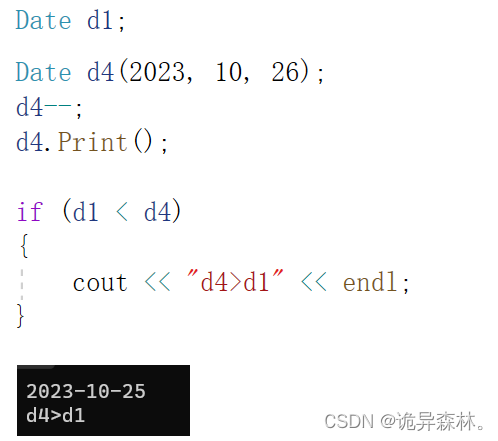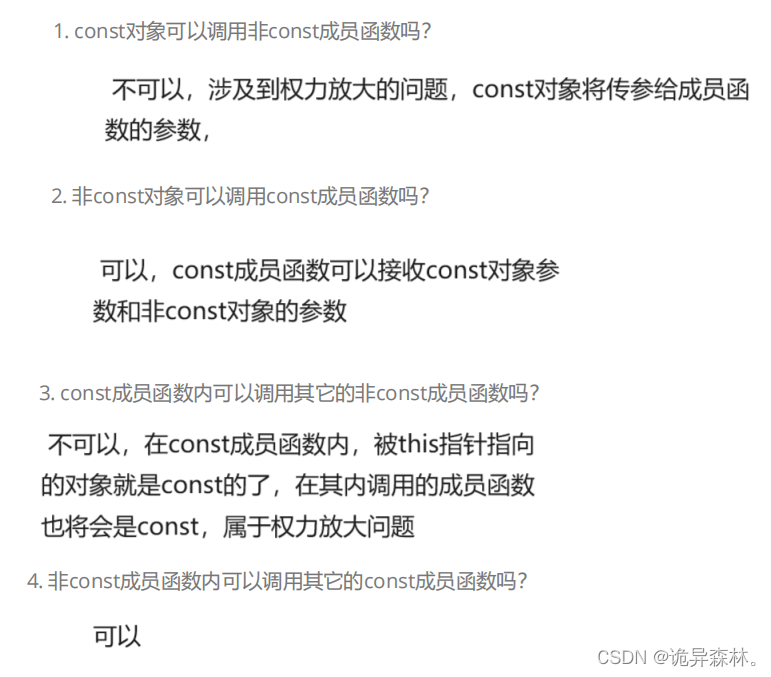const 成员
将const修饰的成员函数称之为const成员函数。
在一个成员函数里面,对于this指针指向的对象,是隐藏式的,没有办法用常规的方法去修饰它,所以我们是这样进行修饰的:
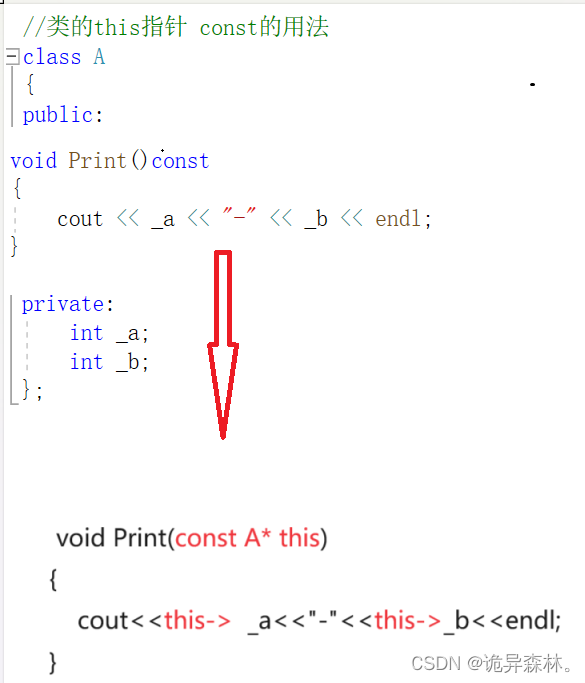
注意事项:
对一个日期类的实现
源码
date.h
#define _CRT_SECURE_NO_WARNINGS 1
#include<iostream>
#include<assert.h>
using namespace std;
class Date
{
private:
int _year;
int _month;
int _day;
public:
Date(int year=1 , int month=1 , int day=1 );
Date(const Date& d);
Date& operator+=(int day);
Date operator+(int day)const;
//日期-天数
Date& operator-=(int day);
//日期-天数
Date operator-(int day)const;
Date& operator++();
Date operator++(int);
Date& operator--();
Date operator--(int);
//日期-日期
int operator-(const Date& d)const;
bool operator>(const Date& d)const;
bool operator<(const Date& d)const;
bool operator==(const Date& d)const;
bool operator>=(const Date& d)const;
bool operator<=(const Date& d)const;
void Print()const;
int GetMonthDay()const;
};
date.cpp
#define _CRT_SECURE_NO_WARNINGS 1
#include"Date.h"
Date::Date(int year,int month,int day)
{
_year = year;
_month = month;
_day = day;
if (_year<1 || _month < 1 || _month>12 || _day>GetMonthDay())
{
Print();
cout << "日期非法" << endl;
}
}
Date::Date(const Date& d)
{
_year = d._year;
_month = d._month;
_day = d._day;
}
void Date::Print()const
{
cout << _year << "-" << _month << "-" << _day << endl;
}
int Date::GetMonthDay()const
{
assert(_year >= 1 && _month >= 1 && _month<=12);
int day=0;
day+= _day;
int Array[] = {
0,31,28,31,30,31,30,31,31,30,31,30,31 };
if (_month == 2 && (_year % 4 == 0 && _year % 100 != 0 || _year % 400 == 0))
{
return 29;
}
return Array[_month];
}
//d1+=50;
Date& Date::operator+=(int day)
{
if (day < 0)
{
return *this -= (-day);
}
_day += day;
while (_day > GetMonthDay())
{
_day -= GetMonthDay();
_month++;
if (_month > 12)
{
_month = 1;
_year++;
}
}
return (*this);
}
//d2=d1+100
Date Date::operator+(int day)const
{
Date tmp(*this);
tmp += day;
return tmp;
}
//d1-=100
Date& Date::operator-=(int day)
{
if (day < 0)
{
return *this += (-day);
}
_day -= day;
while (_day <= 0)
{
_month--;
if (_month == 0)
{
_month = 12;
_year--;
}
_day += GetMonthDay();
}
return (*this);
}
//d1=d2-100
//日期-天数
Date Date::operator-(int day)const
{
Date tmp(*this);
tmp -= day;
return tmp;
}
//++d1
Date& Date::operator++()
{
*this += 1;
return *this;
}
//d1++
Date Date::operator++(int)
{
Date tmp(*this);
*this += 1;
return tmp;
}
//--d1
Date& Date::operator--()
{
*this -= 1;
return *this;
}
//d1--
Date Date::operator--(int)
{
Date tmp(*this);
*this -= 1;
return tmp;
}
bool Date::operator>(const Date& d)const
{
if (_year < d._year)
{
return false;
}
if (_year == d._year && _month < d._month)
{
return false;
}
if (_year == d._year && _month == d._month && _day < d._day)
{
return false;
}
return true;
}
bool Date::operator==(const Date& d)const
{
if (_year == d._year && _month == d._month && _day == d._day)
{
return true;
}
return false;
}
bool Date::operator>=(const Date& d)const
{
return *this > d || *this == d;
}
bool Date::operator<(const Date& d)const
{
return !(*this>d || *this==d);
}
bool Date::operator<=(const Date& d)const
{
return *this < d || *this == d;
}
int Date::operator-(const Date& d)const
{
int day = 0;
Date min = *this;
Date max = d;
if (*this>d)
{
min = d;
max = *this;
}
while (min < max)
{
min++;
day++;
}
return day;
}
解析
这里采用多文件编程的方式,所以在date.cpp中,是在Date类外使用的,需要加上作用域限定符;
对于不改变类对象,也就是this指针指向的对象的,尽量都加上const进行修饰,有一定程度提高效率;
在date.h中,不管成员变量还是成员函数,在类中都只是起到声明的作用,类的成员变量的定义将会在对象中进行定义,类的成员函数都是在date.cpp定义的。
构造函数的验证
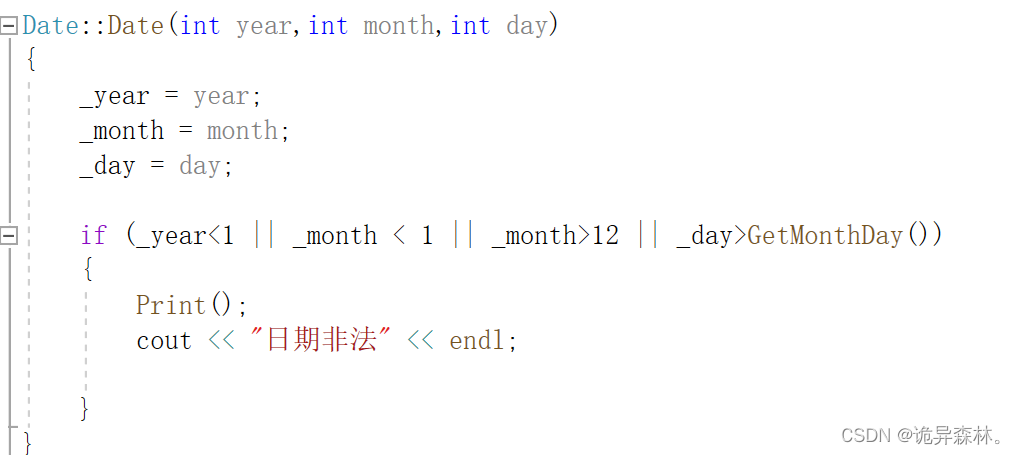
在我们定义时,我们已经加上了缺省值了,
所以在定义时就不用加上缺省值了,加上反而非产生冲突,使编译器无法辨别要哪个缺省值,产生矛盾;
在定义时我们加上了对日期是否合法进行了判断,但没有强制性退出,只是打印警告;
我们将给出三组数据进行验证:
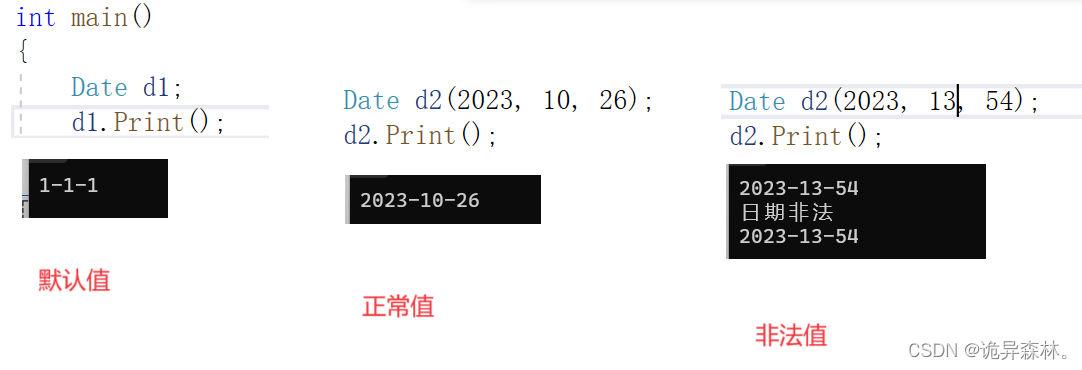
运算符的重复利用
对于重复的步骤,我们可以运用另一个函数来进行完成:
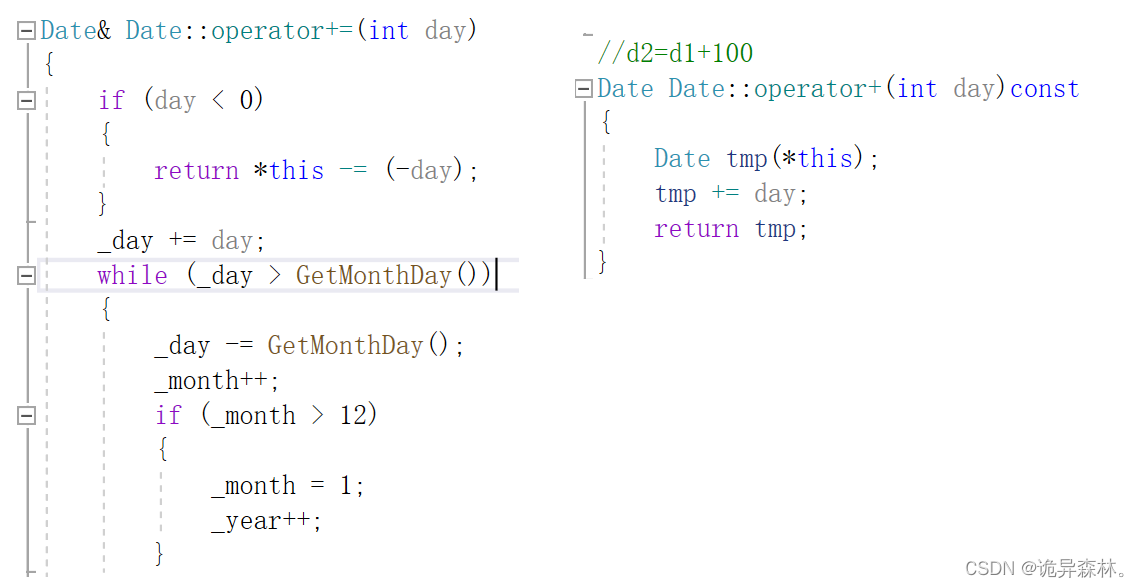
而这里也是有一定讲究的,对于参数和返回值来说,都会创建一个临时变量对象来拷贝传参的值,而这就表示着要调用拷贝构造函数,所以我们在写程序时,要尽量的少调用函数,提高一定的效率;
上述程序中,调用函数次数:
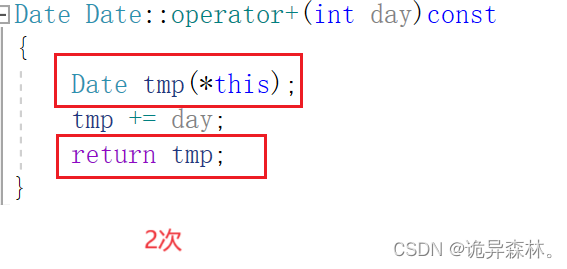
如果我们反过来写的话:
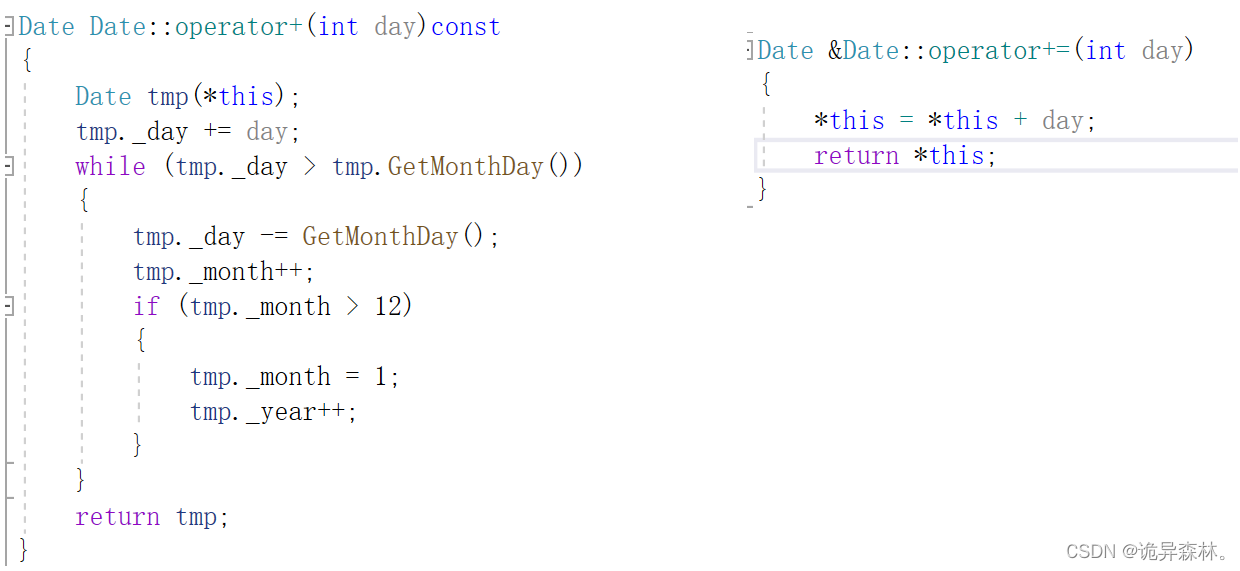](https://img-blog.csdnimg.cn/569d051ee7264a90a4ceb490bb63965c.png)
注意:对于+=来说,会改变this指针指向对象的值,所以这里不能使用const来进行修饰;
而+ 到最后会返回一个值给对应的对象,这个对象不是this指针所指向的对象的,所以可以使用const进行修饰;

我们在date.cpp中没有写明=的重载,类会生成一个默认的运算符重载;

前置++与后置++
在C++中,前置++的重载形式与后置++的重载形式是相同的,为了辨别这两种重载形式,后置++重载时在参数中多加一个int类型的参数,但调用函数时该参数是不参与传递的。

前置++就是直接+=1;而后置++会等到语句结束后才加上1,所以先找一个中间值tmp来进行代替,表示还没有+1;
其他运算符的验证
